JULY 2020 – Sunday, 19th July to be precise. Today was a very interesting day, a very interesting day indeed. I was invited by my friend Mary to one of the less well known islands of the lagoon. The island of San Lazzaro degli Armeni. It’s a small monastery island, a stone’s throw from Lido di Venezia, where a group of Armenian monks have lived and worked for more than 300 years. The island is about 20 minutes by boat from St Mark’s Square. Originally a leper colony, hence the name Lazzaro after Lazarus the patron saint of lepers, the island had been abandoned and was given as a gift to the Armenians by the Venetians. To this day it remains an important monastery, library and sanctuary of Armenian history and culture. It is home to about a dozen Armenian monks. When we visited it was Sunday lunch time and the smell of roasting meat was drifting tantalisingly through the cloisters. Places were set for each of the resident monks in the wood-panelled refectory. I’m sure I wasn’t the only one hoping to be invited for lunch!
OUR YOUNG GUIDE had the most impressive of Armenian names, Shoghik Baghdasaryan. Born into the Armenian Community of Venice, she had lived her entire life in the city. Her first language was Armenian and Italian was her second. Shoghik explained that her name was the equivalent of Lucia in Italian. This won me over immediately, Lucia (Lucy) is one of my favourite saints. It’s also my daughter’s name. In fact I’ve written about Santa Lucia and the church dedicated to her next to the railway station in Venice. They say that Lucy is a giver of light and certainly our guide shared her knowledge of Armenia with us on a hot and humid summer afternoon, surrounded by the lapping waters of the Venetian lagoon. For Shoghik the preservation and appreciation of Armenian culture and heritage isn’t just a passion, it’s a way of life. Firstly and most importantly she started with a map, explaining to us the location of Armenia, which even I as a map-lover and geographer would have struggled to identify precisely.
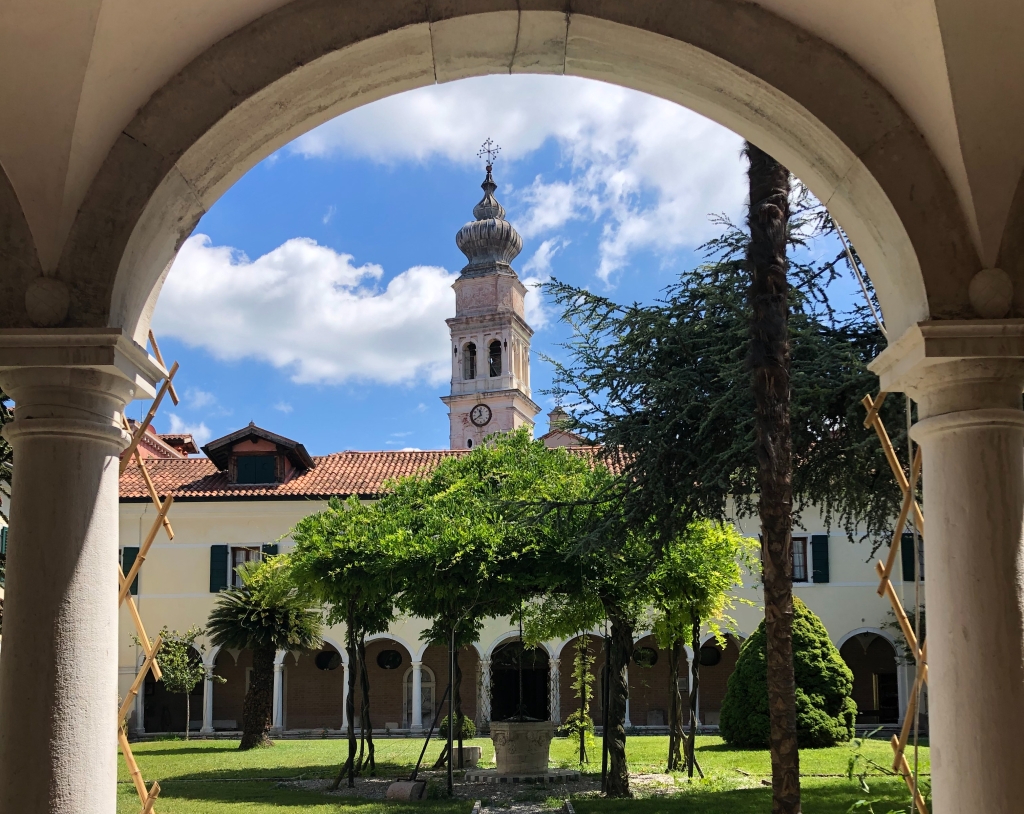
ARMENIA was one of the first eastern countries to adopt Christianity as their official religion in the 4th century. Surrounded by neighbours who were unsympathetic to Christians the Armenians were in a minority and were subjected to endless persecutions over the centuries. Armenia is positioned just north of the Tigris-Euphrates river basin and is bordered by Georgia (formerly USSR) to the north, Turkey to the west and Iran to the south. To the east is Azerbaijan. Over the centuries endless disputes and scuffles led to an emigration (diaspora) of Armenians to more peaceful shores. The Venetians with their history of trade with Asia and a pragmatic attitude to religious tolerance were considered a safe bet for disparate eastern groups. By the 15th century Venice was already home to a large and vibrant Jewish Ghetto, A Greek Community and a German Timber Exchange. A small Armenian community existed too. In fact the Armenian church of Santa Croce still exists a few steps from St Mark’s. Venice was cosmopolitan, international and welcoming to all – especially if trading opportunities followed.


STANDING in the shade of scented pine trees, on a humid and oppressive July day, Shoghik introduced us to the island of San Lazzaro degli Armeni. We stood beneath the looming and slightly worrying bronze statue of MECHITAR the charismatic Armenian monk who arrived in Venice in the early 1700s. Through his charm and wit he managed to persuade a friendly Venetian nobleman and future doge, Sebastiano Mocenigo to allow him and a small group of Armenian monks to settle in Venice permanently. Mocenigo’s main mission in life was to keep the Turks at bay, he’d already strengthened fortifications in Corfu (Venice’s foothold in Greece) so he was probably delighted to have the opportunity to support and help the Armenians, who had always been arch-enemies of the Turks. Throughout history the Venetians were masterful diplomats and negotiators. In terms of strategy there was always an ulterior motive – usually control of trade routes. Mechitar was by no means the first Armenian to arrive in Venice. The Venetians and Armenians had a long history of trading together. Ever since the days of Marco Polo, Armenia was a key stopping off point on the Silk Road to China. There was already a small community of Armenians living in Venice by the late 15th century. In fact the first book to be printed in the Armenian language was printed in Venice in 1512. It sits proudly in a temperature-controlled glass cabinet inside the island’s library. However Mocenigo’s gift of the island of San Lazzaro to the Armenians gave the monks a home, a territory, a sound foundation where they could live and work in safety. The Venetians gave the Armenians a secure future.

INDUSTRIOUS – The Armenians were a hard-working and scholarly bunch, once they’d been given permission to live on San Lazzaro they set about restoring the abandoned island. They rebuilt the church, created a garden and planted crops. Once the island was habitable they established a library and a printing press. They started translating manuscripts and books into Armenian. They then printed and bound the books on the island, creating a unique Armenian library recording the history, culture and literature of the Armenian people. This hard-working monastic community has thrived ever since. Now the story suddenly gets even more interesting. The Armenians impressed numerous visitors to Venice with their hard work and resilience, especially the very hard-to-please Napoleon. He arrived in Venice in 1797 with his Austrian Allies and effectively took control of the Venetian Republic, thus ending 1000 years of independence for the people of Venice. Napoleon suppressed many of the monasteries in Venice, because he saw them as a threat to his power. However the Armenian community survived because of the scholarly nature of their community which enabled them to define themselves as an academy (accademia) rather than a monastery. Having been persecuted for centuries the Armenian monks knew a thing or two about survival. So with careful use of language the Armenian community on the island of San Lazzaro was authorised by Napoleon as an academic institution of great cultural and historical importance to the people of Armenia. Just a decade or so later the English poet, writer and all round ‘bon viveur’ Lord Byron arrived, he too was captivated by the Armenian spirit and their unique culture. This wonderful painting of Lord Byron arriving on the island of San Lazzaro degli Armeni hangs in the National Gallery of Armenia in Yerevan, such is Armenian pride in Lord Byron’s involvement in their community.

SURPRISE – What I hadn’t been expecting as our little tour group wandered into the cloisters of the monastery was the exceptional beauty and homeliness of the buildings. Polished terracotta paving stones almost sparkled beneath our feet. Out of the corner of my eye I caught a fleeting glimpse of a monk, wearing a brown cassock making his way to the chapel to prepare for morning service. The central courtyard garden was filled with fruit trees and vines, all luxuriant and bursting with life. A carpet of emerald green grass, neatly groomed, covered the ground. There was even a pergola offering shade around a central well-head. I found myself beginning to understand the fascination that Lord Byron felt for this special Armenian community, comfortably embedded on their island in the middle of the Venetian Lagoon, where they’d recreated their own little ‘Garden of Eden’.


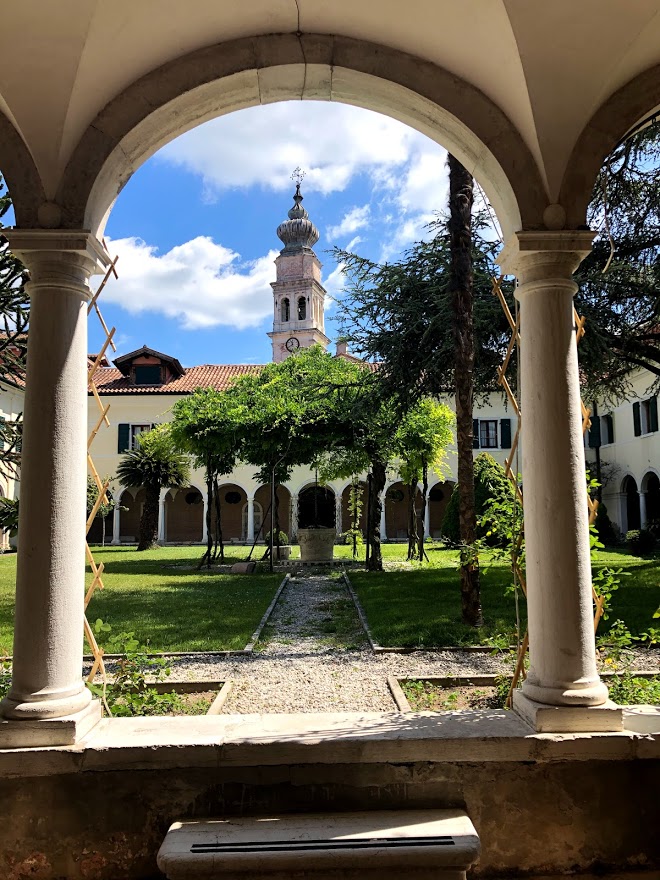




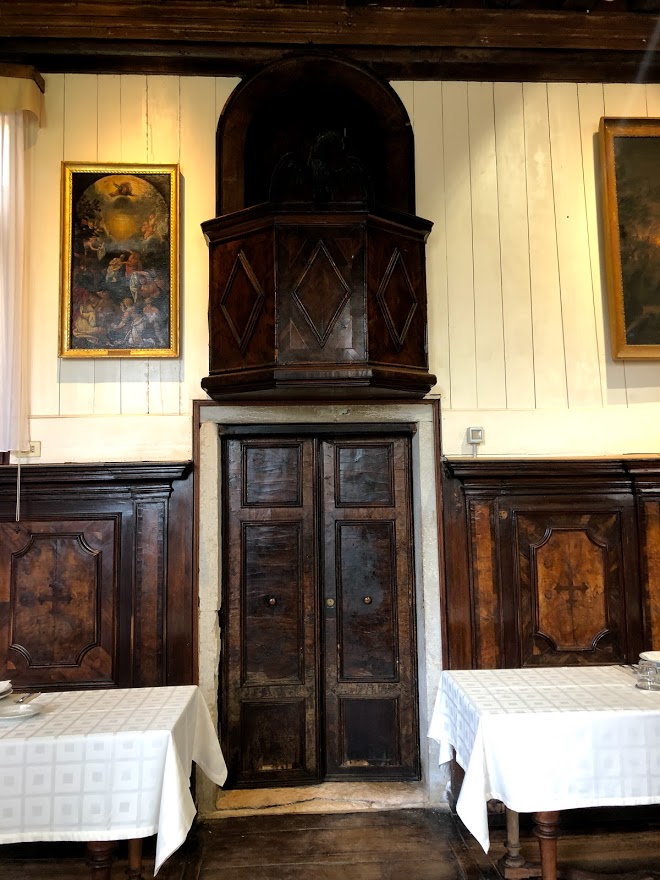


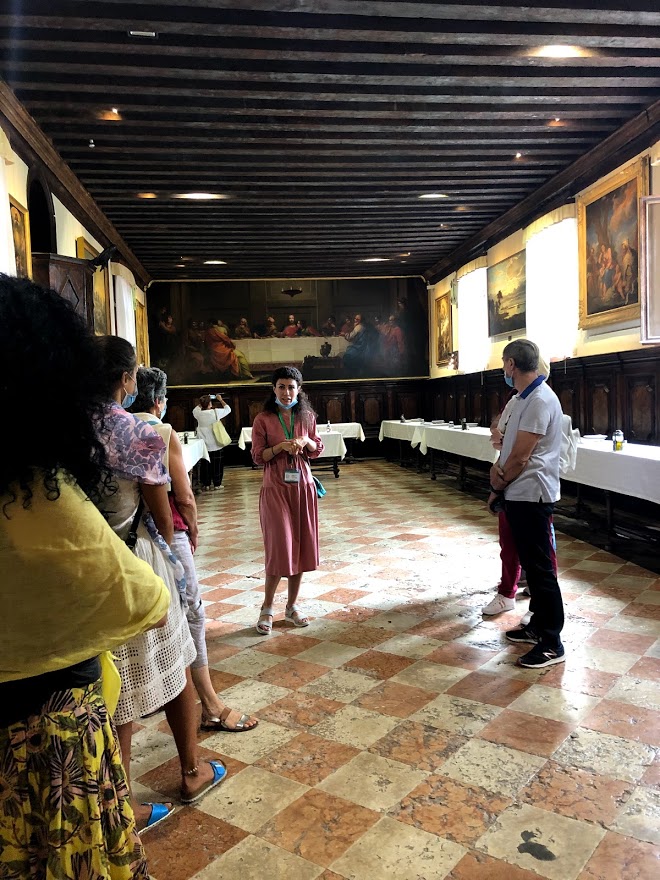


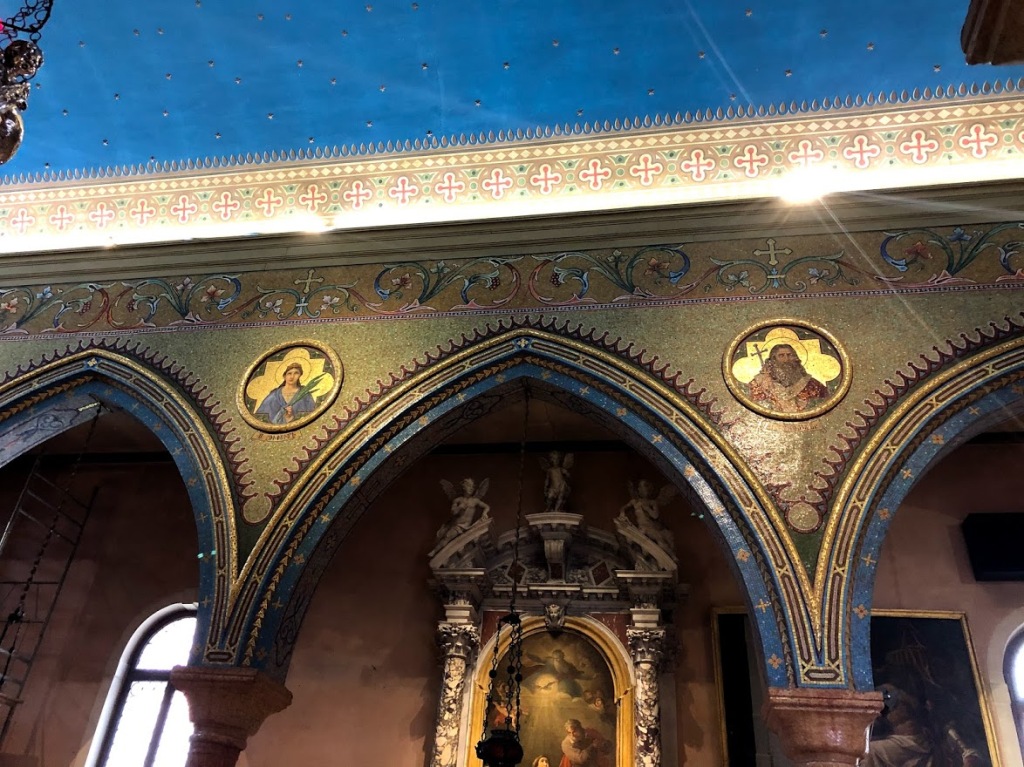


GUESTS IN A PRIVATE HOME – The course of our visit included the cloisters and the church. Next we saw the dining room and corridors and then the library, Byron’s study and a unique museum dedicated to the history of Armenian culture. It was a privilege to learn about and discover the rich heritage of the Armenian people. Even more special was the feeling of being invited into someone’s home. Lunch was cooking in the kitchen and we could smell it, delicious aromas wafted through the ancient wooden doors that separated the refectory from the cloisters. Meanwhile in the church two of the monks were preparing for morning service, their robes and cassocks were neatly folded on a timber bench spied through the vestry door (which was slightly ajar). This place was living and breathing, the island was filled with life and hope and soul. We were on-lookers in a unique and magical world. Officially the guide books tell us that San Lazzaro degli Armeni is a small island in the Venetian Lagoon which has been home to the monastery of the Mekhitarists, an Armenian Catholic congregation, since 1717. However it is so much more than that. It is a home and also a unique, spiritual kingdom.
LORD BYRON & LITERATURE – Having first impressed the Venetians and then Napoleon with their scholarly and studious life style, the monks next significant important visitor was English poet, gentleman and ‘lover of life’ Lord Byron. Byron arrived in Venice in November 1816. He was tired and jaded by social scandals and a failed marriage. He visited the monks at San Lazzaro and immersed himself in the study and learning of the Armenian language. As a ‘thank you’ and repayment for the monks kindness Byron covered the costs of printing an Armenian-English grammar book. He spent the winter of 1816/1817 studying Armenian and by early 1817 he was able to translate from Armenian into English. His study and desk remain as they were in Byron’s day, just over 200 years ago. It is an intriguing window into the life of a British poet, whose brief stay with the monks enabled him to learn a new skill and refocus his artistic and literary skills. Having arrived in Venice in no mood to write poetry Byron’s stay on San Lazzaro was a period of learning and inspiration. By the spring of 1817 Byron was writing poetry again,
..’I’ve taught me other tongues – and in strange eyes
Have made me not a stranger; to the mind
Which is itself, no changes bring surprise..’
Extract from ‘Childe Harold’ 4th Canto – ‘other tongues’ refers to Byron’s learning of Armenian.
THE LIBRARY – The library on San Lazzaro houses almost 180,000 manuscripts, texts and valuable books. These include translations of numerous Greek and Latin texts into Armenian covering all aspects of literature and history. The oldest book in the collection was printed, in Venice, in 1512. To ensure continuity and editorial control the monks established their own printing press. This allowed them to print new books and expand their library at will. It also gave them complete independence and freedom to choose which books they printed. In the last three centuries the monks have created one of the finest libraries in the Mediterranean Basin and certainly the finest collection of Armenian literature in the world. This library is housed in an elegant rotonda-style room, the interiors are climate-controlled, and numerous glass cases house the most valuable texts. I have to remind myself that I’m stood on a small island in the middle of the Venetian lagoon, surrounded by water. In terms of overcoming adversity the Armenians win the gold medal for determination and persistence. After all an island in the middle of a humid lagoon would not be everyone’s first choice for a permanent collection of valuable books.


INSPIRATION AND A LOCAL VENETIAN BOY – The Armenian ability to influence and inspire those around them continues with the delightful story of Gianni Basso, a young Venetian boy who visited the Armenian island with his grandfather Giuseppe in the 1960s. Giuseppe provided a boat service that linked San Lazzaro with the nearby island of Lido. Several times a week Giuseppe delivered fruit, vegetables, meat and fish to the neighbouring island. Young Gianni would go with him to lend a hand. He’d watch the monks creating and printing books. It was a fascination that would last a lifetime. Later Gianni became an apprentice to the monks and learned the printers’ craft. When the monks decided to adopt modern printing techniques, it was Gianni who took the old, manual presses and created his own ‘stamperia’ printing shop, in Venice’s Cannaregio district, continuing to use the traditional machines of the Armeni. Gianni’s ‘stamperia’ continues in business to this day offering traditional, hand-printed cards, business cards and pamphlets. A visit to Gianni’s shop is a must! I’ve written about Gianni and his traditional print shop here: Venice – a traditional printer at work


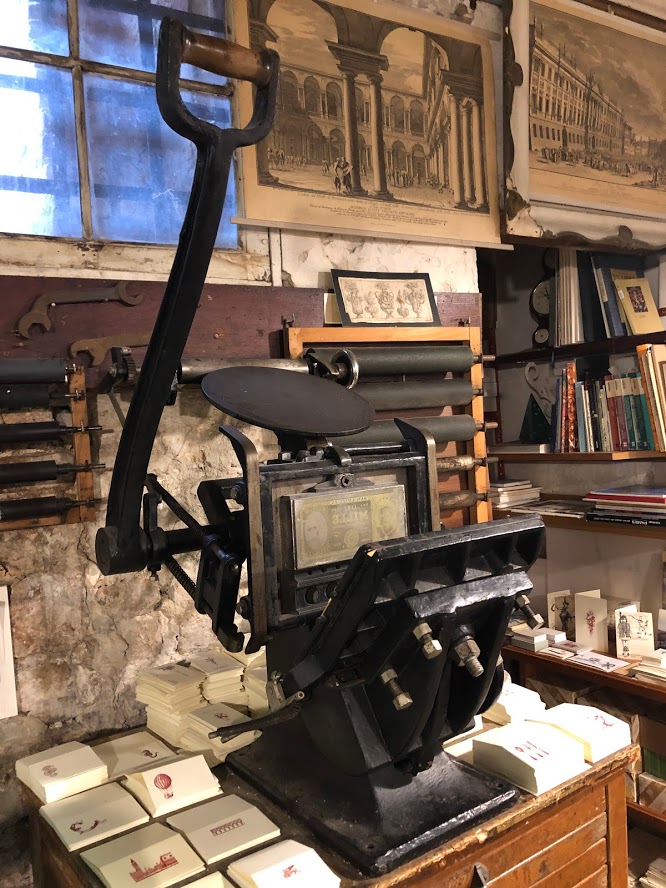

HUMILITY – As our visit to the island of San Lazzaro draws to a close I reflect on the endurance, determination and fortitude of the Armenian monks who created this paradise island in the lagoon. Their faith and commitment and their single-mindedness are all traits that are sadly lacking in our modern and superficial world. It is fascinating to think that this small island, a former leper colony, became a monastery, printing workshop and library of international importance. This island is a living tribute to the power of hard work and a studious approach to life. The Armenian presence lives on not just in Venice but throughout the world. The Armenians have always recognised the power of words, something that Byron realised too. I’d like to finish with one of my favourite Byron quotes,
…”But words are things, and a small drop of ink, Falling, Like dew, Upon a thought, Produces that which makes thousands, perhaps millions think”….
And here in the middle of the lagoon of Venice the Armenians have certainly achieved the impossible………


NOTES:
- For the full story of Santa Lucia The legend of St Lucy – Santa Lucia in Italy
- For more on Gianni Basso and his traditional printing shop: Venice – a traditional printer at work
- The monastery of San Lazzaro is open every day at 3.25 pm for a guided visit.
- Some say that when Joseph Stalin fled Russia he worked briefly as a bell ringer on San Lazzaro!
- To arrange a visit to San Lazzaro with Shoghik Baghdasaryan, my wonderful guide, you can find her on Instagram @guidaavenezia and also: shoghik55.bagh@gmail.com Alternatively you can contact janet@grand-tourist.com and I’ll put you in touch.
- www.greyhoundtrainers.com blog is a cornucopia of articles about history, geography, art and culture spanning Italy, France, The Alps and British Isles. Indulge yourself, dip into these pages that help to define and shape our European cultural landscape.
- Further reading – Venice: There’s treasure around every corner
- Magical and unexpected discoveries in Venice: Venice – Botticelli in Venice – seriously?
- A little bit of spiritual guidance: Saints and Angels in Venice…
FURTHER READING:
- Here’s a link from ‘Gruaro di Venezia’ interesting and informative article about San Lazzaro (in italian): http://www.laruotagruaro.it/reportage/le-isole-di-venezia/san-lazzaro-degli-armeni
- A delightful short article on Lord Byron and the Armenian Community in Venice from the Milwaukee Armenians: https://milwaukeearmenians.com/2018/01/19/lord-byron/
- An article from Syracuse University, NY – discussing Lord Byron and the Armenians. https://surface.syr.edu/cgi/viewcontent.cgi?article=1080&context=libassoc
- Visited: July 2020
- Written and amended: October, November 2020, January 2021
- August 2023




Thank you, Janet, for your insightful article, which is rich in fascinating details about the history of Armenians in Venice. We are planning a trip to Venice next week and, inspired by your piece, we have decided to include the island of San Lazzaro degli Armeni in our itinerary.
LikeLiked by 1 person
Great news – enjoy!
LikeLike
Thank you for this bit of history, Janet–I love your description of the courtyard. And to think people are still being influenced by the bookmakers/printers after all this time!
LikeLiked by 1 person
Thank you Mary Lou – always nice to see your comments – thank you xxx
LikeLike
Another REALLY interesting article, Janet – thank you so much. It’s like being at school again, but without the pain, the boredom or the tyerrible food, and being left with the delightful food – for the mind! I really enjoyed this article, and learnt a lot. Congratulations and thank you as always!
John
LikeLiked by 1 person
Thank you John – the island of San Lazzaro is quite enchanting – I understand completely why Byron moved in there (at least until the parties of Carnival started)!!!
LikeLike